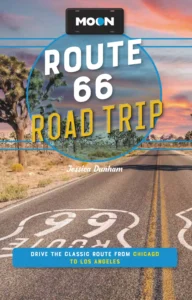St. Louis
Driving to St. Louis
The Great River Road has many routes in, around, and across St. Louis, and they’re all so poorly marked that you’re sure to get lost trying to follow any of them. From Alton, US-67 crosses just below Lock and Dam No. 26, taking first the Clark Bridge (over the Mississippi) and then the Lewis Bridge (over the Missouri River).
No prizes for guessing what those names refer to, since coming from the north you enter the city on Lewis and Clark Boulevard (Hwy-367).
A good main non-freeway route across St. Louis is Kings Highway, which runs north-south past many of the city’s main destinations, including Forest Park and the Missouri Botanical Garden, before ending up at Gravois Avenue, part of old Route 66. From here, numerous roads give direct access to I-55 and US-61, which link up with the scenic GRR route south to Sainte Genevieve.
Visiting St. Louis
Founded by French fur trappers in 1764, St. Louis served for most of its first century as a prosperous outpost of civilization at the frontier of the Wild West. It was the starting point for the explorations of Lewis and Clark, and much later Charles Lindbergh, whose Spirit of St. Louis carried him across the Atlantic. Unfortunately, like many other American cities, St. Louis has suffered from years of decline and neglect; the population, which peaked at over 850,000 in 1950, is now less than half that. In recent years the racialized violence in its northern suburb Ferguson made national headlines. Even the sale of the city’s iconic beer brand, Budweiser, to the Belgian company InBev was a blow to local pride. Part of the problem may be that, although it has all the cultural and institutional trappings of a major city, not to mention the landmark Gateway Arch, St. Louis is, at heart, a city of small neighborhoods, such as bluesy Soulard south of downtown, the Italian-American “Hill” (boyhood home of baseball legend Yogi Berra), and the collegiate West End district near verdant Forest Park.
One thing you have to see when in St. Louis (you literally cannot miss it) is the Gateway Arch National Park (daily, 877/982-1410), still dominating the city skyline. Eero Saarinen’s stunning 630-ft (192-m) stainless-steel monument, officially called the Jefferson National Expansion Memorial, rises up from the riverfront at the foot of Market Street. A small tram ($12) carries visitors to an observation chamber at the top. Under the legs of the arch, the free and fascinating Museum of Westward Expansion chronicles the human wave that swept America’s frontier west to the Pacific. St. Louis has invested more than $400 million on a “CityArchRiver” project to reconnect the city with its riverfront.
West of downtown around the Washington University campus, in Forest Park’s 1,300 beautifully landscaped acres (526 ha), museums of fine art, history, and science fill buildings that date back to the 1904 World’s Fair, St. Louis’s world-class swan song.
The St. Louis Cardinals (314/345-9600), one of the country’s most popular baseball teams, play at retro-modern Busch Stadium, right downtown, with views of the river and Gateway Arch. Games are broadcast on KMOX 1120 AM.
Where to Eat and Stay in St. Louis
Freeways and high-speed arteries reminiscent of Los Angeles make a car handy for navigating the St. Louis area—unless you have oodles of money for cab fares. Thanks to the city’s sad history of replacing its landmark buildings with blacktop, you’ll find plenty of parking lots around downtown.
For food, The Hill neighborhood is hard to beat: Gian-Tony’s (5356 Daggett Ave., Suite 3028, 314/772-4893) is perhaps the best of a dozen classic neighborhood Italian places. Wherever you go, try the toasted ravioli, a local treat. Near Washington University, another great place is the slightly kitschy Blueberry Hill (6504 Delmar Blvd., 314/727-4444), a retro-1950s diner that has an excellent jukebox, good burgers, and enough real-life credibility to have attracted the likes of the late St. Louis-born father of rock ’n’ roll, Chuck Berry, to play impromptu gigs.
No one leaves St. Louis without cruising old Route 66 southwest from downtown to Ted Drewes (6726 Chippewa St., 314/481-2652), a local institution famous for its many flavors of “concrete”—a delicious frozen dairy-and-egg-custard concoction so thick you can turn it upside down and not spill a drop. Nearby, fried chicken fans flock to Hodak’s (2100 Gravois Ave., 314/776-7292). One last Route 66 place has been going strong for more than 60 years: the Eat-Rite Diner (622 Chouteau Ave., 314/621-9621), a plain blue-and-white cube serving up breakfasts and burgers daily. As the sign says: “Eat Rite, or Don’t Eat at All.”
St. Louis doesn’t have that much of a tourist trade—the muggy weather here in summer keeps most sensible people far away—so places to stay are relatively cheap. At the Gateway Arch, Hampton Inn St. Louis-Downtown (333 Washington Ave., 314/621-7900, $105 and up) is one of the more popular downtown hotels. The Hyatt Regency St. Louis at the Arch (315 Chestnut St., 314/655-1234, $149 and up) is another. In a historic reincarnation, a quartet of stately old warehouses has been converted to house the Westin St. Louis (811 Spruce St., 314/621-2000, $371 and up), near the arch, the river, and the baseball stadium.
Travel Maps of the Great River Road and Missouri


















